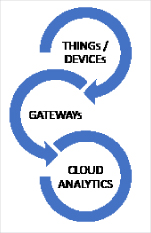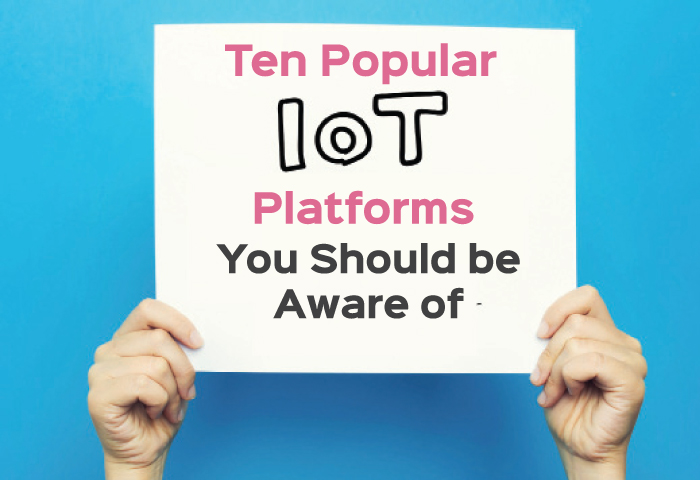Let’s take a quick look at the trending IoT platforms and their features.
Every Internet of Things (IoT) device expands connectivity beyond standard devices, namely, computers, laptops and smartphones. Its integration with low energy wireless technology enables communication over the internet. Today these devices have innumerable applications in the domains of agriculture, healthcare, automation, Industrial IoT, wearables and logistics.
There are many platforms that are being used extensively to build IoT solutions. We take a look at the ten open source IoT platforms that seem to be very popular today due to various reasons.

Arduino IoT Cloud
URL: https://cloud.arduino.cc/
One of the best-known open source platforms, Arduino encompasses both hardware and software. The software includes an integrated development environment (IDE) for writing code in the Arduino language. Connected devices around the world are increasing by billions every year. The Arduino IoT Cloud is a platform that allows anyone to develop IoT solutions. It has a user-friendly interface, and an all-in-one solution for configuration, writing code, uploading and visualisation. Its features include data monitoring, variable synchronisation, scheduler, over-the-air (OTA) uploads, WebHooks, Amazon Alexa support, and dashboard sharing.
Its subscription plans are Free, Entry, Maker and Maker Plus. Paid plans are offered on a monthly and yearly billing cycle, except for the Entry plan, which is only available on a yearly basis.
OpenRemote
URL: https://openremote.io/
OpenRemote is an intuitive, user-friendly, 100 per cent open source IoT device management platform for original equipment manufacturers (OEMs), integrators and governments. Its functions and features include building applications for services, configuring dashboards; building logic with When-Then, Flows, Javascript or Groovy; and customised apps under the AGPLv3 license. The major domains it is used in include energy management and smart cities.
Mainflux
URL: https://mainflux.com/
Mainflux is a performant and secure open source IoT platform with full-scale capabilities for developing IoT solutions, IoT applications and smart connected products. Built as a set of microservices containerised by Docker and orchestrated with Kubernetes, the Mainflux IoT platform serves as a software infrastructure and middleware which provides device management, data aggregation and data management, connectivity and message routing, core analytics, and application enablement. Mainflux Labs (under an Apache 2.0 license) is the technology company that offers end-to-end, open source, edge computing gateway and consulting services for the software and hardware layers of IoT technology.
ThingsBoard
URL: https://thingsboard.io/
This platform offers the Community Edition, the Professional Edition and Cloud. The Community Edition is completely free. ThingsBoard is an open source IoT platform meant for device management, data collection, processing and visualisation to build the IoT solution. This enables you to connect devices, push data from devices, build real-time end-user dashboards, define thresholds, trigger alarms, and push notifications about new alarms over email, SMS or other systems.
Table 1: Features of the various IoT platforms
| IoT platform | Integration | Protocols | Security | Free and open source |
| Arduino IoT Cloud | REST APIs | MQTT | Basic authentication | Up to two devices |
| OpenRemote | WebSocket, HTTP, MQTT APIs | HTTP, MQTT, KNX | AES, 256-bit encryption | Yes |
| Mainflux | REST APIs | HTTP, MQTT, CoAP | TLS v1.3 | Yes |
| ThingsBoard | WebUI, REST APIs | HTTP, MQTT, CoAP | Basic authentication | Yes |
| Thinger.io | REST APIs | HTTP, MQTT, CoAP | SSL/TLS | Up to two devices |
| Kaa | Portable SDKs | HTTP, MQTT, CoAP | TLS / DTLS | Up to five devices |
| Blynk | REST APIs | HTTP, MQTT | Basic authentication | Up to two devices |
| SiteWhere | REST APIs | MQTT, AMQP | SSL | Yes |
| ThingSpeak | REST APIs, MQTT APIs | MQTT | Basic authentication | Yes |
| Zetta | WebSocket, REST APIs | MQTT | Basic authentication | Yes |
Thinger.io
URL: https://thinger.io/
In Thinger.io you have an easy-to-navigate, ready-to-use cloud infrastructure that allows users to integrate, monitor, and control millions of IoT devices. It helps to connect an API, supports geofencing, and can create custom alerts using real-time data from devices. It permits you to collect and store data in the platform, and create dashboards with custom or built-in widgets. There is also a provision to share dashboards with customers and on the cloud.
Thinger.io offers the following three choices – Community, Private Cloud and On-Premise. The Community plan provides free access for evaluation and testing that is limited to two devices, simple analytics and a single tenant.
Table 2: Device management, visualisation and analytics of the IoT platforms
| IoT platform | Device management | Data visualisation | Analytics | Multi-tenancy |
| Arduino IoT Cloud | Yes | Yes | Yes | – |
| OpenRemote | Yes | Yes | Yes | Yes |
| Mainflux | Yes | Grafana | Yes | Yes |
| ThingsBoard | Yes | Dashboard widgets | Yes | Yes |
| Thinger.io | Yes | Grafana | Yes | Yes |
| Kaa | Yes | Direct/IoT gateway | Yes | Yes |
| Blynk | Yes | Yes | Yes | Yes |
| SiteWhere | Yes | Grafana | Can detect outliers too | Yes |
| ThingSpeak | Yes (with MATLAB) | MATLAB visualisation app | Yes | – |
| Zetta | Yes | Yes | Yes | Yes |
Kaa
URL: https://www.kaaiot.com/
Kaa provides a flexible, multi-purpose middleware platform for developing end-to-end IoT solutions, connected applications, and smart devices. Its products are diversified into Kaa IoT Platform, Kaa Cloud, Kaa IoT Gateway, Kaa IAM and Kaa Cloud Migration. It has applications in the domains of agriculture, healthcare, automation, Industrial IoT, wearables and logistics. It offers an end-to-end IoT development experience with its customisable microservice architecture and open protocols.
Plans include Kaa Cloud 5, Kaa Cloud 15, and Kaa Cloud 100, of which only Kaa Cloud 5 offers a 14-day free trial on up to five connected devices with multi-user access.
Blynk
URL: https://blynk.io/
Blynk helps to build and manage connected hardware. It offers device provisioning, sensor data visualisation, remote control with mobile and web applications, over-the-air firmware updates, secure cloud, data analytics, user and access management, alerts and automations. The Blynk IoT platform prototypes, deploys, and remotely manages connected electronic devices at any scale.
Blynk powers low-batch manufacturers of smart home products, complex HVAC systems, agricultural equipment, and everyone in between. It offers two plans — Free and Business.
SiteWhere
URL: https://sitewhere.io/en/
SiteWhere provides a multi-tenant microservice-based infrastructure that includes the key features required to build and deploy IoT applications. SiteWhere infrastructure and microservices are deployed on Kubernetes, allowing for deployment on-premise or almost with any cloud provider. It runs on Apache Tomcat and offers MongoDB and HBase implementations. You can deploy SiteWhere to cloud platforms like AWS, Azure, GCP, or on-premise.
ThingSpeak
URL: https://thingspeak.com/
ThingSpeak is an IoT analytics platform service that allows you to aggregate, visualise, and analyse live data streams in the cloud. You can send data to ThingSpeak from your devices, create instant visualisation of live data, and send alerts. Data collection in the cloud with advanced data analysis using MATLAB is possible.
Zetta
URL: https://www.zettajs.org/
Zetta is an open source platform built on Node.js for creating IoT servers that run across geo-distributed computers and the cloud. Zetta combines REST APIs, WebSockets and reactive programming perfect for assembling many devices into data-intensive, real-time applications. It is a server-oriented platform with a flow-based reactive programming development philosophy and connected by cloud services to develop IoT frameworks. These cloud services include visualisation tools and support for machine analytics tools like Splunk. It creates a zero-distributed network by connecting endpoints such as Linux and Arduino hacker boards with platforms such as Heroku.geet




